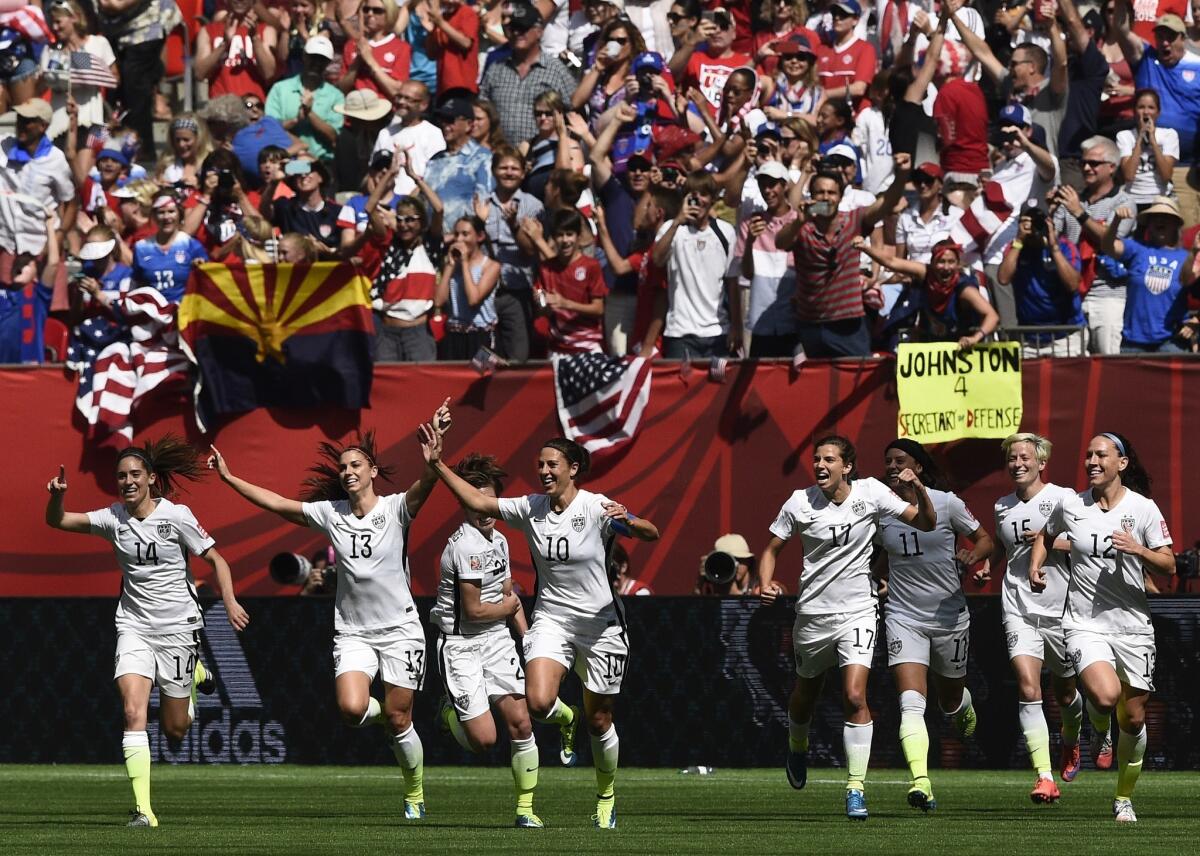And now, back to obscurity for the U.S. women’s national team

Midfielder Carli Lloyd (10) and he United States teammates celebrate one of her three goals in the Women’s World Cup Final against Japan.
- Share via
Why do Americans care so much about the U.S. women’s national team in the World Cup when they don’t seem to care much at all about the professional soccer teams that feature the very same women?
One could ask the same question about women’s team sports in general. We seem to get all revved up when American women are chasing a world championship -- an Olympic gold medal, say, or a Women’s World Cup -- but where’s the splashy national TV coverage for the WNBA playoffs?
Don’t blame the broadcasters. They follow the audience, they don’t lead it.
The truth is, Americans embrace their national teams when they’re beating other countries’ top talent. With the exception of a handful of men’s sports, though, they’re not so interested when the members of those teams beat each other.
In soccer’s case, the latest version of the men’s professional league seems to have established large enough local followings to soldier on in that second tier of sports without broadcast TV coverage. But the top women’s league -- the nine-team National Women’s Soccer League -- is in only its third season, which is precisely as long as its two predecessors lasted before folding.
The NWSL has only three teams in the country’s 20 largest cities -- those would be the clubs in Chicago, Houston and Seattle, although you could argue that the Sky Blue Football Club in Piscataway, N.J., isn’t that far from Philadelphia. The closest club to California is the Portland Thorns in Oregon. Aside from Houston’s Dash, which employs World Cup goal-scoring machine Carli Lloyd, there are no teams in the Southeast or the Southwest.
Those teams may all have loyal followings locally. That doesn’t translate, however, into cities across the country clamoring for franchises or broadcasters getting into a bidding frenzy over the rights to air the games.
After every strong women’s national team performance in the World Cup, pundits effuse about the inspiration that the players provide to girls across America. And thanks to Title IX, soccer does provide a ticket for talented and determined young soccer players to get a college education on scholarship. But it won’t offer much of a career path until the audience that shows up for the World Cup sticks around to watch the players do their thing on a smaller stage.
Soccer enthusiasts have also been saying for many years that the sport’s growing popularity among American youths will eventually make it the kind of national obsession that it is in much of the rest of the world. That’s not even close to happening yet. Although it’s conceivable that parents’ growing reluctance to let their kids play tackle football might allow soccer to eventually take its place in the national sports psyche, the insane loyalty that college football has inspired makes such a shift seem remote at this point (and a soccer pitch isn’t exactly a concussion-free zone either).
There is something all of the new fans of women’s soccer can do, however, to help the NWSL grow from a regional phenomenon into a national one. As the national team was starting its march to the World Cup finals, the league and Fox Sports 1 announced a deal to televise seven regular-season games and three playoff matches on the latter’s cable network. The ratings for those games will determine whether the women’s professional soccer goes into hibernation for another four years, until the next dominant American women’s team takes on the rest of the world.
Follow Healey’s intermittent Twitter feed: @jcahealey
More to Read
A cure for the common opinion
Get thought-provoking perspectives with our weekly newsletter.
You may occasionally receive promotional content from the Los Angeles Times.










